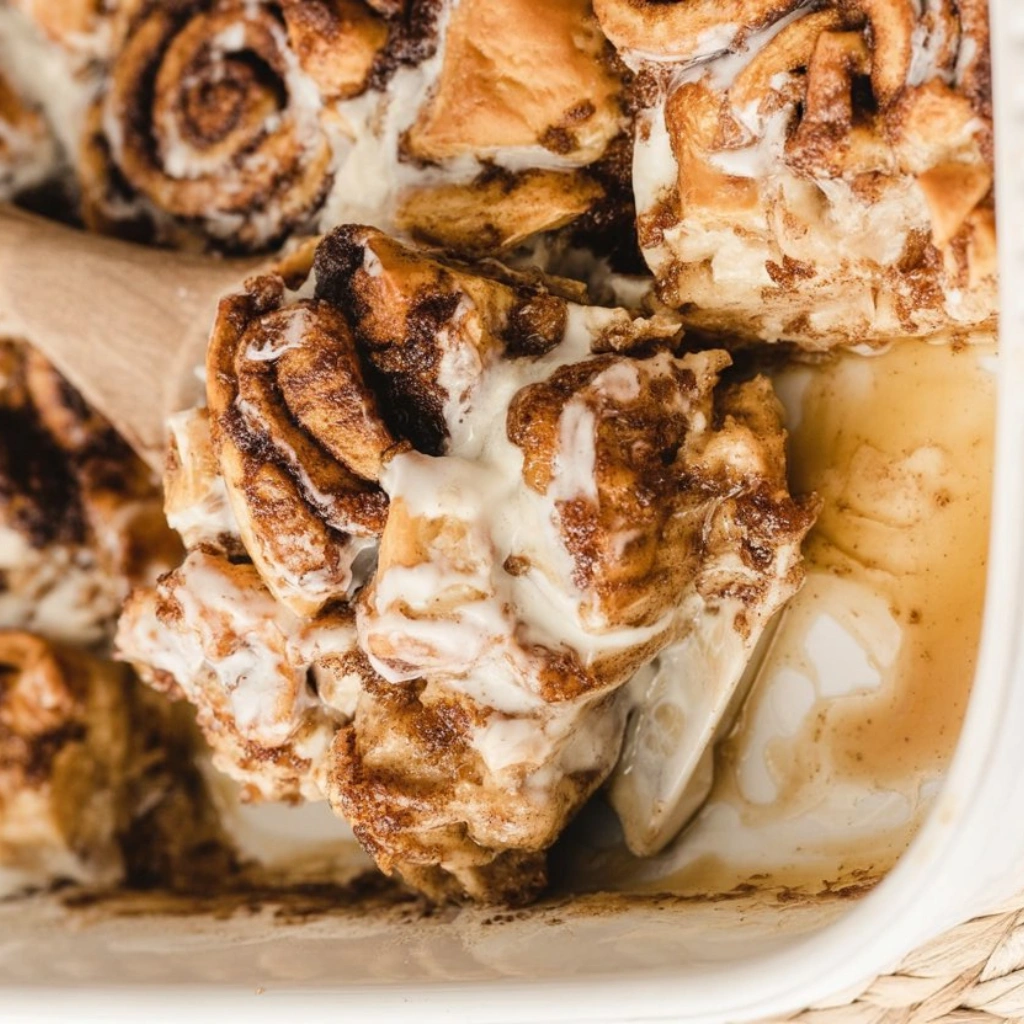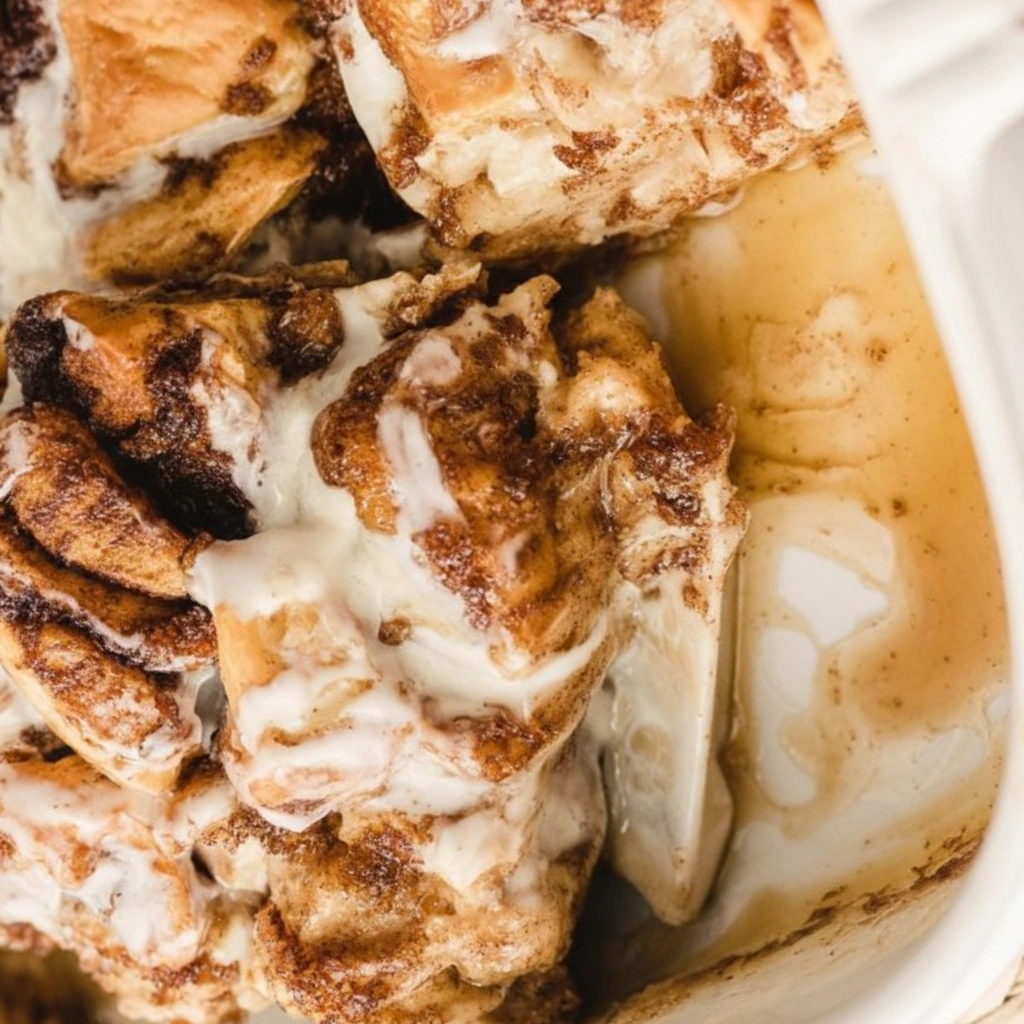There’s something about cinnamon rolls that takes me right back to my childhood kitchen—the smell of butter, brown sugar, and cinnamon drifting through the air on a slow Sunday morning.
I remember my mom rolling out dough on the counter, the surface dusted with flour, while I stood nearby watching the spirals take shape. She’d always let me drizzle the glaze once they cooled, a job I took far too seriously for an eight-year-old. Years later, when I had my own kitchen and my own hungry crew to feed, I found myself craving that same cozy magic—but not the early morning labor it required. That’s how this cinnamon roll casserole was born: a shortcut that keeps all the nostalgia and comfort, but lets me stay in my pajamas a little longer.
This recipe is one of those beautiful “why didn’t I think of that sooner?” moments. It captures everything I love about traditional cinnamon rolls—the soft, gooey texture, the caramelized edges, and the creamy glaze—but transforms it into a simple, family-style bake. Whether I’m hosting brunch or just want to treat my family on a lazy weekend, this casserole never fails to bring everyone to the table in record time.

Why You’ll Love This Recipe
- Warm, comforting, and perfect for any morning or holiday brunch
- Easy to prepare with minimal hands-on time
- Uses store-bought cinnamon rolls or homemade dough
- Feeds a crowd effortlessly
- Delicious both fresh and reheated
- Customizable with nuts, fruit, or flavored glaze
Ingredients You’ll Need
Cinnamon Rolls – You can use two 12–16 oz cans of refrigerated cinnamon rolls (I often grab Pillsbury for convenience), but if you’re feeling ambitious, homemade dough works beautifully too. If you use homemade rolls, cut them into bite-sized pieces before layering.
Eggs – Four large eggs help bind everything together and create that soft, custard-like texture that makes this casserole so comforting.
Heavy Cream or Half-and-Half – This adds richness and moisture. I’ve tried using whole milk in a pinch—it still works, but the texture is slightly less decadent.
Cinnamon and Vanilla Extract – These deepen the flavor and bring out that bakery-style warmth. A touch of nutmeg is lovely if you enjoy a bit of spice.
Brown Sugar – For extra sweetness and a hint of molasses flavor. I like using light brown sugar for a balanced taste, but dark brown adds a more caramelized note.
Melted Butter – It gives that glossy, buttery finish and helps the top bake into a golden crust.
Powdered Sugar, Milk, and Cream Cheese (for glaze) – If your cinnamon rolls come with icing packets, you can use those, but I prefer whipping up a quick homemade glaze. Just whisk together softened cream cheese, powdered sugar, a splash of milk, and vanilla until smooth and pourable.
How to Make It (Step-by-Step Instructions)
Step 1: Prep Your Baking Dish
Start by preheating your oven to 375°F (190°C). Lightly grease a 9×13-inch baking dish with butter or nonstick spray. I’ve learned the hard way that this step matters—cinnamon sugar can be sticky, and you’ll want those caramelized edges to lift right out.
Step 2: Cut the Cinnamon Rolls
Open the cans of cinnamon rolls and set the icing packets aside. Cut each roll into quarters. The smaller pieces create more pockets for the custard mixture to soak in, giving you that perfect mix of gooey and fluffy textures.
Step 3: Layer the Rolls
Scatter the cinnamon roll pieces evenly across the baking dish. It doesn’t need to be perfect—those uneven layers actually make for a better bite.
Step 4: Make the Custard Mixture
In a medium bowl, whisk together the eggs, heavy cream, vanilla extract, cinnamon, brown sugar, and melted butter. Pour this mixture evenly over the cinnamon roll pieces. I like to gently press the rolls down a bit so they soak up all that liquid gold.
Step 5: Bake
Place the casserole in the preheated oven and bake for 30–35 minutes, or until the top is golden brown and the center is just set. If the edges start to brown too quickly, you can tent it with foil halfway through. When it’s done, the kitchen will smell like a cozy bakery—sweet, buttery, and impossible to resist.
Step 6: Prepare the Glaze
While the casserole bakes, prepare your glaze. In a small bowl, whisk together powdered sugar, softened cream cheese, a splash of milk, and vanilla until smooth. You can adjust the thickness by adding a bit more milk if needed.
Step 7: Cool Slightly and Glaze
Let the casserole rest for about 10 minutes before drizzling with the glaze. This short rest helps the custard finish setting and ensures your glaze doesn’t just melt away. I like to drizzle half the glaze first, then save the rest for serving—because let’s be honest, everyone wants a little extra.

Expert Tips for the Best Results
The trick to a perfect cinnamon roll casserole is balance—you want the edges slightly crisp but the center soft and gooey. Don’t overbake it; even a few extra minutes can dry it out. I’ve found that letting the rolls soak in the custard mixture for a few minutes before baking helps create that luscious, bread-pudding-like consistency. If you prefer extra flavor, sprinkle chopped pecans or a handful of raisins between the layers. And if your glaze feels too thick, warm it slightly before drizzling—it’ll glide beautifully over every swirl. Most importantly, serve it warm. That’s when the butter, sugar, and spice truly come alive.
Variations & Substitutions
Over the years, I’ve played around with this recipe in more ways than I can count. One Christmas morning, I didn’t have heavy cream, so I used eggnog instead—it turned out so festive that it became a family favorite. You can also swap the canned rolls for brioche chunks and treat it like a cinnamon bread pudding. For fruit lovers, toss in diced apples or blueberries before baking. I’ve even added a layer of cream cheese filling between the roll pieces for a rich, cheesecake-like surprise. No matter how you tweak it, the heart of the recipe stays the same—warm, comforting, and irresistibly simple.
Serving Suggestions
This cinnamon roll casserole shines brightest at brunch tables, especially during the holidays or cozy weekends when everyone’s lingering in their pajamas. I love serving it with scrambled eggs, bacon, and a pot of hot coffee for balance. It also pairs beautifully with fresh fruit or a simple yogurt parfait if you want to lighten things up. On Christmas morning, I’ll often bake it the night before and warm it up just as everyone starts waking. The smell alone feels like a celebration.
Storage & Reheating Instructions
If you have leftovers (which is rare in my house), store them in an airtight container in the refrigerator for up to three days. To reheat, I recommend warming individual servings in the microwave for about 20–30 seconds or in the oven at 325°F for 10 minutes. The texture stays surprisingly soft, especially if you cover it with foil. If it feels a little dry after reheating, drizzle on a touch of extra glaze or even a spoonful of cream before warming—it brings it right back to life.
Recipe FAQs (Answered by Clara)
Can I make this ahead of time?
You sure can. I often prepare it the night before, cover it tightly, and refrigerate. The rolls soak up more flavor overnight, and it bakes up even softer the next morning.
Can I use homemade cinnamon rolls instead of store-bought?
Absolutely. Just cut your dough into small pieces before layering. You may need to extend the baking time slightly since homemade dough tends to be denser.
Can I serve it cold?
Technically yes, but I prefer it warm. When the glaze melts slightly into the casserole, the texture becomes almost creamy—exactly what makes it special.
How do I make it less watery?
If your casserole turns out soggy, it’s usually because the rolls didn’t soak evenly or it was underbaked. Make sure to whisk the custard thoroughly and bake until the center is just set. Letting it cool for a few minutes before slicing also helps firm things up.

Conclusion
Every time I make this cinnamon roll casserole, I’m reminded of why I love home cooking so much—it’s not about perfection; it’s about creating something that feels good. This recipe brings that warm, homemade magic without the fuss. It’s the kind of dish that makes mornings feel special, even on an ordinary day. If you give it a try, I’d love to hear how it turns out for you. Share your twist in the comments or tag me if you make it—I’m always curious how these recipes live on in your kitchens. And if you’re anything like me, you might just find yourself making it more often than you planned.
Nutrition Information (per serving)
- Calories: 380
- Fat: 19g
- Saturated Fat: 10g
- Carbohydrates: 45g
- Sugar: 26g
- Protein: 6g
- Fiber: 1g
- Sodium: 420mg

Cinnamon Roll Casserole
Ingredients
- 2 cans 12–13 oz each refrigerated cinnamon rolls, cut into quarters
- 4 large eggs
- ½ cup heavy cream or whole milk
- 3 tablespoons melted butter
- 1 teaspoon vanilla extract
- 1 teaspoon ground cinnamon
- ¼ cup maple syrup optional, but recommended
- Pinch of salt
- Icing packets from the cinnamon roll tubes for topping
Instructions
- Preheat oven to 350°F (175°C). Grease a 9×13-inch baking dish.
- Cut each cinnamon roll into quarters and spread the pieces evenly in the prepared baking dish.
- In a medium bowl, whisk together the eggs, heavy cream, melted butter, vanilla, cinnamon, maple syrup, and salt until smooth.
- Pour the custard mixture evenly over the cinnamon roll pieces.
- Let the casserole rest for 5 minutes so the rolls absorb some of the mixture.
- Bake for 28–32 minutes, or until golden on top and the center is set.
- Allow to cool for 5 minutes, then drizzle the included icing over the warm casserole.
- Serve warm.
Notes
- Add fruit: Stir in diced apples, blueberries, or sliced bananas before baking.
- Extra glaze: Make additional icing with powdered sugar and milk if you prefer a sweeter finish.
- Make ahead: Assemble the casserole the night before, refrigerate, and bake in the morning—add 5 extra minutes to bake time.
- Storage: Refrigerate leftovers for up to 3 days. Reheat in the oven for best texture

